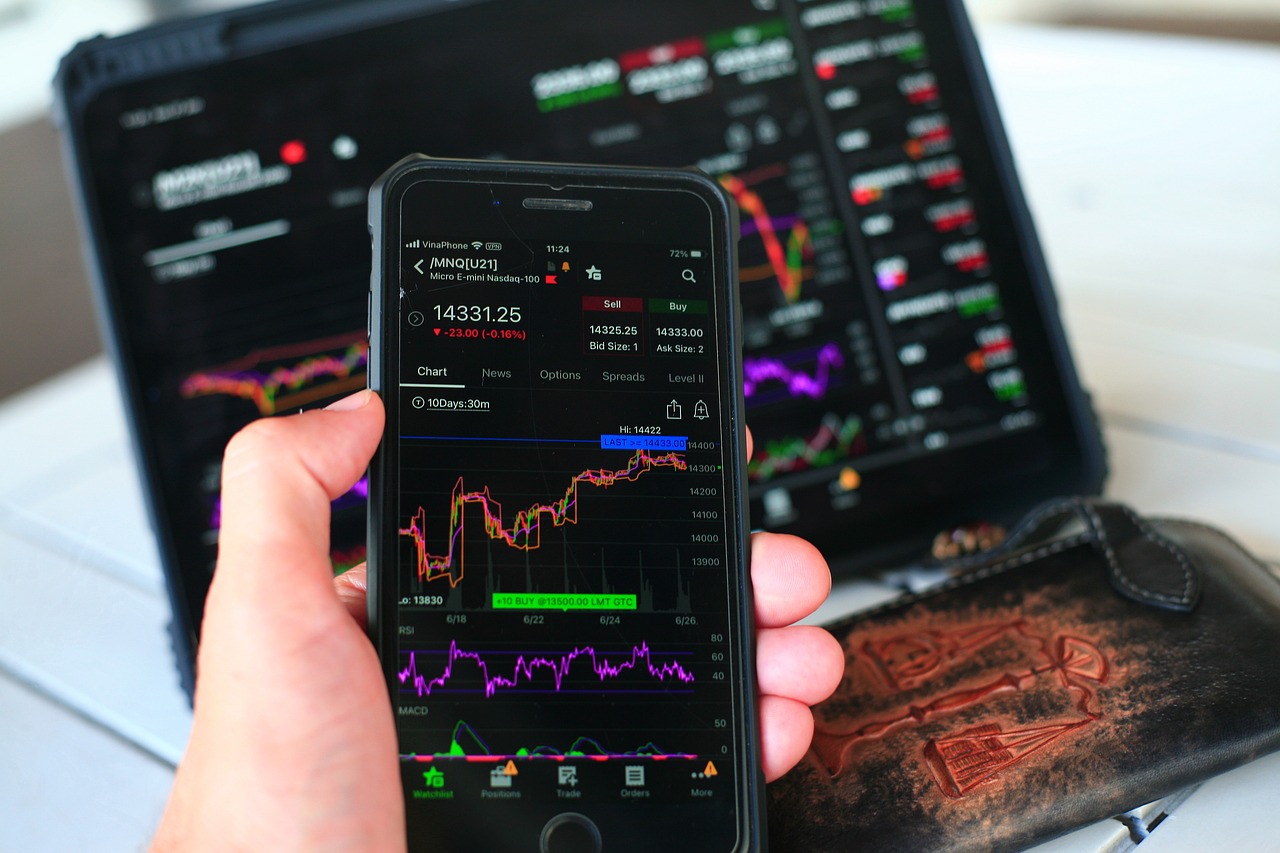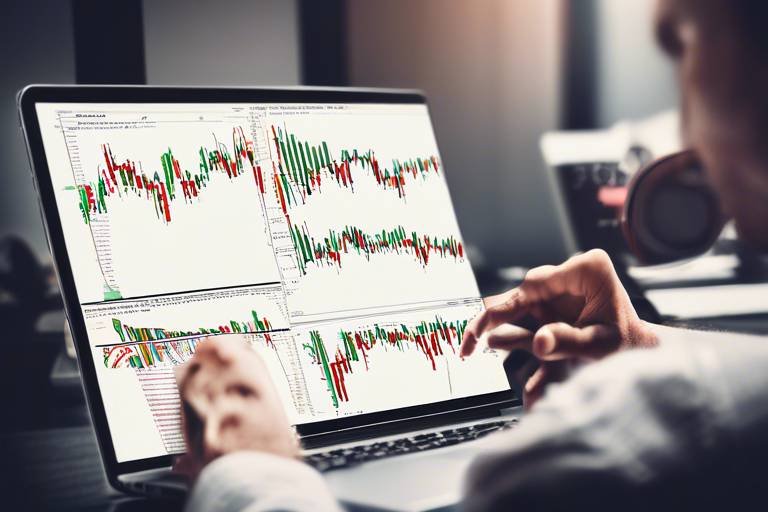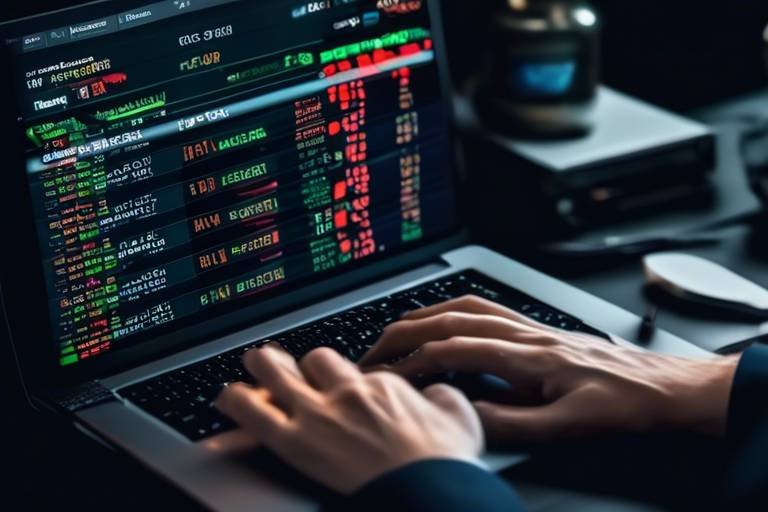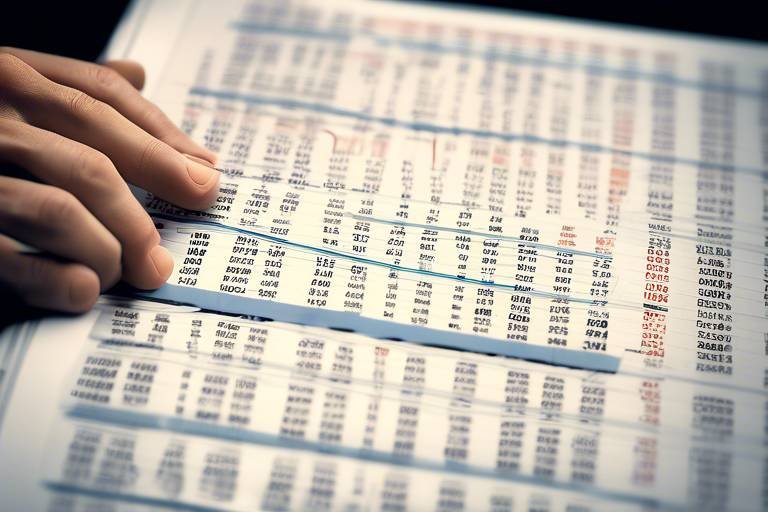Strategies for Trading on Different Exchanges
In today's fast-paced financial landscape, trading on different exchanges can feel like navigating a labyrinth. Each exchange has its own unique characteristics, quirks, and opportunities. The key to successful trading lies in understanding these differences and tailoring your strategies accordingly. Whether you're a newbie or a seasoned trader, knowing how to adapt your approach can make all the difference between profit and loss.
Let’s dive into the heart of trading strategies that can help you thrive across various exchanges. First off, it's essential to grasp the market dynamics. Different exchanges operate under different conditions, influenced by factors such as trading volumes, liquidity, and market trends. For instance, a high-volume exchange might offer better liquidity, allowing for quicker trades and less slippage. On the other hand, niche exchanges may offer unique assets that could yield significant profits if you know how to leverage them.
So, how do you choose the right exchange for your trading activities? This decision can be pivotal. You’ll need to consider several factors:
- Security: Look for exchanges with robust security measures in place.
- Fees: Different exchanges have varying fee structures that can impact your bottom line.
- Available Assets: Ensure the exchange offers the assets you wish to trade.
- User Experience: A user-friendly interface can significantly enhance your trading experience.
Security is paramount in trading. Always seek exchanges that provide features like two-factor authentication, cold storage for assets, and a clear regulatory compliance track record. Regulatory compliance not only ensures that the exchange operates within the law but also adds a layer of safety for your investments. It’s like having a safety net while you perform your high-flying acrobatics in the trading arena.
Next, let’s talk about the fee structures. Different exchanges have different fees that can eat into your profits. Here’s a quick breakdown of common fee types:
| Fee Type | Description |
|---|---|
| Trading Fees | Fees charged for executing trades. |
| Withdrawal Fees | Fees for transferring assets out of the exchange. |
| Deposit Fees | Fees for depositing funds into your account. |
Understanding these fees can help you make informed decisions about where to trade. Now, let’s not forget about the variety of available assets on different exchanges. Some platforms focus solely on cryptocurrencies, while others may offer stocks, commodities, or forex. Knowing which assets are available can significantly influence your trading strategies and potential returns.
Once you've chosen your exchange and assets, it's time to focus on risk management. Effective risk management techniques are essential for long-term success in trading. This includes setting stop-loss orders to limit potential losses and diversifying your portfolio to spread risk. Think of it as not putting all your eggs in one basket; instead, you're scattering them across multiple baskets to minimize the risk of a total loss.
Diversification strategies can be a game-changer. By spreading your investments across various assets and exchanges, you can reduce your exposure to any single market downturn. This approach can help cushion the blow when things go south. Additionally, understanding position sizing is crucial. It involves determining the right amount to invest in each trade based on your overall risk tolerance. This is like deciding how much weight you can lift at the gym without risking injury.
Moreover, utilizing trading tools can enhance your trading performance. Charting software, for instance, is invaluable for technical analysis. It helps you identify trends and make informed decisions based on historical data. On the other hand, automated trading systems can save you time and effort. They execute trades on your behalf based on predefined criteria, allowing you to capitalize on opportunities even when you're not actively monitoring the market.
Finally, developing a structured trading plan is essential. A well-defined trading plan outlines your goals, strategies, and risk management practices. It acts as your roadmap, guiding your trading decisions effectively. Setting realistic goals based on your experience level and market conditions ensures you stay focused and disciplined. Regularly reviewing and adjusting your strategies is also crucial to adapt to changing market conditions and improve your results.
- What is the best exchange for beginners? It depends on your needs, but look for user-friendly interfaces and low fees.
- How can I ensure my investments are secure? Use exchanges with strong security measures, including two-factor authentication.
- What are stop-loss orders? These are orders placed to sell an asset once it reaches a certain price, limiting your losses.
- Why is diversification important? Diversification helps to spread risk and can protect you from significant losses in a single market.

Understanding Market Dynamics
When it comes to trading, understanding market dynamics is crucial for success. Each exchange operates differently, influenced by a myriad of factors such as trading volumes, liquidity, and the types of assets available. Have you ever wondered why some exchanges experience sudden price spikes while others remain stable? This variance can be attributed to the unique characteristics of each platform and the broader market trends that affect them. For instance, exchanges that cater primarily to retail investors may exhibit different trading behaviors compared to those that focus on institutional trading.
One of the key elements to consider is the trading volume. High trading volumes typically indicate a healthy market where buyers and sellers can transact easily, leading to tighter spreads and less slippage. Conversely, exchanges with low trading volume may experience more volatility, making it riskier for traders. Understanding these volume dynamics can help you time your trades better. You might find it helpful to analyze the average daily trading volumes of various exchanges to identify where you can get the best execution for your trades.
Additionally, the market trends play a pivotal role in shaping trading strategies. For example, during a bullish market, traders might adopt more aggressive strategies, buying into rising assets. In contrast, during bearish trends, the focus may shift toward protecting capital. It's essential to keep an eye on global economic indicators, news events, and other external factors that can influence market sentiment. By doing so, you can anticipate shifts in trading dynamics and adjust your strategies accordingly.
Moreover, different exchanges offer various trading tools and features that can significantly impact your trading experience. Some platforms provide advanced charting tools, while others may focus on social trading features that allow you to follow and mimic successful traders. Understanding what each exchange offers will help you choose the right platform that aligns with your trading style and objectives. Here’s a quick comparison of some popular exchanges and their unique characteristics:
| Exchange | Trading Volume | Available Assets | Unique Features |
|---|---|---|---|
| Exchange A | High | Cryptos, Stocks | Advanced Charting |
| Exchange B | Medium | Cryptos | Social Trading |
| Exchange C | Low | Commodities | Futures Trading |
In conclusion, grasping the intricacies of market dynamics is essential for any trader. By understanding how different exchanges operate and the factors that influence their performance, you can make more informed trading decisions, ultimately enhancing your overall trading experience. So, the next time you log into your trading platform, remember to consider these dynamics—your profits may just depend on it!

Choosing the Right Exchange
When you dive into the world of trading, selecting the right exchange can feel like choosing the perfect surfboard before hitting the waves. It’s crucial to find a platform that not only fits your trading style but also enhances your overall experience. There are several factors to consider, each playing a pivotal role in ensuring optimal trading conditions. Let’s break down these key elements to help you make an informed choice.
First and foremost, security should be at the top of your list. Imagine investing your hard-earned money and then discovering that the exchange you chose was compromised. To avoid such nightmares, look for exchanges that offer robust security measures, such as two-factor authentication and cold storage for digital assets. These features significantly reduce the risk of hacking and theft.
Next up, consider the fee structures of various exchanges. Fees can vary widely and can significantly impact your profitability. Some exchanges charge trading fees, while others may impose withdrawal fees. A quick comparison table can help you visualize how these fees stack up:
| Exchange | Trading Fees | Withdrawal Fees |
|---|---|---|
| Exchange A | 0.1% | $0.50 |
| Exchange B | 0.2% | $1.00 |
| Exchange C | 0.15% | $0.75 |
As you can see, even a small difference in fees can add up over time, so it’s essential to choose wisely. Additionally, think about the available assets on each exchange. Are you looking to trade cryptocurrencies, stocks, or commodities? Different exchanges cater to different types of assets, so ensure that the exchange you choose offers the variety you need to implement your trading strategies effectively.
User experience is another critical aspect. A user-friendly interface can make your trading journey much smoother. If the platform is clunky and hard to navigate, it can lead to missed opportunities and frustration. Therefore, take the time to explore the exchange’s interface and features before committing.
Lastly, don’t overlook the importance of customer support. In the fast-paced world of trading, having access to reliable support can be a lifesaver. Look for exchanges that offer 24/7 customer service through various channels, such as live chat, email, and phone support. This way, if you encounter any issues, help is just a click away.
In summary, choosing the right exchange involves a careful evaluation of security measures, fee structures, available assets, user experience, and customer support. By keeping these factors in mind, you’ll be well on your way to selecting a trading platform that aligns with your goals and enhances your trading experience.
- What should I prioritize when choosing an exchange? Focus on security, fees, available assets, user experience, and customer support.
- Are all exchanges regulated? No, not all exchanges are regulated. It’s important to choose one that complies with local regulations for added security.
- Can I trade multiple assets on one exchange? Many exchanges offer a variety of assets, but it’s best to check if your desired assets are available.
- How do fees affect my trading profits? Higher fees can eat into your profits, so it’s crucial to choose an exchange with competitive fees.

Security Measures
When it comes to trading on different exchanges, security should be your top priority. The digital landscape is rife with risks, and ensuring the safety of your investments is crucial. First and foremost, look for exchanges that offer two-factor authentication (2FA). This adds an extra layer of protection by requiring not only your password but also a second form of verification, typically a code sent to your mobile device. It's like having a double lock on your front door—much harder for intruders to breach!
Another important aspect of security is the use of cold storage for your assets. Cold storage refers to keeping your cryptocurrencies offline, away from the internet, which significantly reduces the risk of hacking. Think of it as storing your valuables in a safe rather than leaving them out in the open. Many reputable exchanges utilize cold storage to protect the majority of their clients' funds, ensuring that even in the event of a cyberattack, your assets remain secure.
Furthermore, you should always check for regulatory compliance. Exchanges that adhere to regulations are generally more trustworthy. They are required to follow strict guidelines and undergo regular audits, which can provide you with peace of mind. It’s akin to choosing a restaurant that has passed health inspections—you want to know that your investments are in safe hands.
To give you a clearer picture, here’s a quick comparison of the security measures offered by some popular exchanges:
| Exchange | Two-Factor Authentication | Cold Storage | Regulatory Compliance |
|---|---|---|---|
| Exchange A | Yes | 75% of funds | Yes |
| Exchange B | Yes | 90% of funds | Yes |
| Exchange C | No | 50% of funds | No |
As you can see, not all exchanges are created equal when it comes to security. It's essential to do your research and choose an exchange that prioritizes your safety. Additionally, always be on the lookout for any security breaches reported by the exchange. If they have a history of hacks or poor security practices, it might be wise to steer clear.
Lastly, remember that your own practices matter too. Regularly updating your passwords, using unique passwords for different accounts, and being cautious of phishing attempts can go a long way in safeguarding your investments. After all, the best defense is a good offense!
- What is two-factor authentication? Two-factor authentication is a security process that requires two different forms of identification before accessing your account.
- How does cold storage work? Cold storage keeps your cryptocurrency offline, making it less susceptible to hacking.
- Why is regulatory compliance important? Regulatory compliance ensures that an exchange follows legal guidelines, offering an additional layer of security for your investments.
- What should I do if I suspect a security breach? Immediately change your passwords, enable 2FA if you haven't already, and contact the exchange's customer support.

Regulatory Compliance
When it comes to trading on exchanges, is not just a buzzword; it’s a crucial aspect that can significantly impact your trading experience and security. Think of it as the safety net that ensures you’re operating within the law and that your investments are protected. Regulatory bodies oversee exchanges to ensure they adhere to specific standards that safeguard investors against fraud and malpractice. So, why should you care about compliance?
First, trading on regulated exchanges means you can have greater peace of mind. These exchanges are required to implement stringent measures to protect your funds and personal information. For instance, they must conduct regular audits and comply with anti-money laundering (AML) and know your customer (KYC) regulations. This not only helps in preventing illicit activities but also ensures that the exchange is operating transparently.
Moreover, regulatory compliance can significantly affect your trading experience. If an exchange is compliant, it often means they have a robust customer support system, clear policies regarding withdrawals, and a transparent fee structure. This can lead to a smoother trading experience where you can focus more on your strategies rather than worrying about the legitimacy of the platform. On the other hand, trading on unregulated exchanges can expose you to various risks, including the potential loss of your funds without any recourse.
Here’s a quick comparison of the benefits of trading on regulated versus unregulated exchanges:
| Aspect | Regulated Exchanges | Unregulated Exchanges |
|---|---|---|
| Security | High; regular audits and compliance checks | Variable; often lacks transparency |
| Customer Support | Reliable; established support channels | Inconsistent; may lack support |
| Withdrawal Policies | Clear and regulated | Often vague and unpredictable |
| Risk of Fraud | Low; monitored by regulatory bodies | High; potential for scams |
In conclusion, choosing to trade on a regulated exchange is akin to driving on a well-paved road versus a bumpy, unmarked path. The former offers safety, predictability, and peace of mind, while the latter can lead you into a world of uncertainty and risk. Always do your due diligence and ensure that the exchange you choose adheres to the necessary regulations to protect your investments.
1. What is regulatory compliance in trading?
Regulatory compliance in trading refers to the adherence of exchanges and traders to laws and regulations set by governing bodies to ensure fair practices and protect investors.
2. Why is it important to trade on a regulated exchange?
Trading on a regulated exchange minimizes the risk of fraud, ensures your funds are secure, and provides a more reliable trading experience.
3. How can I verify if an exchange is regulated?
You can verify if an exchange is regulated by checking its licensing information on the website of the relevant regulatory body or by looking for certifications displayed on the exchange's platform.

Fee Structures
When diving into the world of trading, understanding the of different exchanges is crucial. These fees can significantly impact your overall profitability, and overlooking them can lead to unexpected costs. In general, there are several types of fees that traders should be aware of, including trading fees, withdrawal fees, and deposit fees. Each exchange has its own unique fee schedule, which can vary widely depending on the platform and the assets being traded.
Trading fees are typically charged as a percentage of the trade value or as a flat fee per transaction. For example, some exchanges may charge a 0.1% fee for each trade, while others might have a flat fee structure, such as $0.50 per trade. Understanding whether your exchange uses a maker-taker model or a flat fee structure can help you make more informed trading decisions. In a maker-taker model, liquidity providers (makers) pay lower fees than those who take liquidity (takers), which can influence your trading strategy.
Withdrawal fees are another important aspect to consider. After all, what's the point of trading if you can't access your profits? Most exchanges charge a fee for withdrawing funds, which can vary based on the asset type. For instance, withdrawing Bitcoin might incur a fee of 0.0005 BTC, while withdrawing fiat currency could come with a fee of $5. It's essential to factor these costs into your overall trading strategy, especially if you plan to make frequent withdrawals.
Additionally, some exchanges may impose deposit fees, although this is less common. These fees can be charged when you transfer funds into your trading account, and they can eat into your initial investment. It's wise to read the fine print of each exchange's fee structure to avoid any surprises.
| Fee Type | Example Fee | Notes |
|---|---|---|
| Trading Fee | 0.1% or $0.50 | Varies by exchange and trading volume. |
| Withdrawal Fee | 0.0005 BTC or $5 | Depends on the asset being withdrawn. |
| Deposit Fee | $0 - $5 | Less common; check specific exchange policies. |
In essence, when selecting an exchange, always take a close look at the fee structures. These fees can have a cumulative effect on your trading results, so being proactive about understanding them is vital. A small fee here and there might not seem like much at first, but over time, they can add up and significantly reduce your returns. By doing your homework and comparing fee structures across different exchanges, you can ensure that you're making the most of your trading endeavors.
- What are trading fees? Trading fees are charges applied by exchanges for executing a buy or sell order. They can be based on a percentage of the trade value or a fixed amount.
- How do withdrawal fees work? Withdrawal fees are charges that exchanges impose when you transfer your funds out of their platform. These fees can vary by asset and exchange.
- Can I avoid trading fees? Some exchanges offer fee-free trading for certain assets or for users who meet specific trading volume thresholds. Always check the exchange's policies.
- Are deposit fees common? Deposit fees are less common than trading and withdrawal fees, but some exchanges may charge a fee for certain deposit methods.

Available Assets
When diving into the world of trading, one of the most exciting aspects is the variety of assets available across different exchanges. Each platform offers a unique mix of assets, which can significantly influence your trading strategies. Imagine walking into a vast marketplace where every stall offers something different; this is akin to navigating through various exchanges. Some may specialize in cryptocurrencies, while others might focus on traditional assets like stocks or commodities.
Cryptocurrencies have taken the trading world by storm, with platforms like Binance and Coinbase leading the charge. Traders can access a plethora of digital currencies, from well-known giants like Bitcoin and Ethereum to emerging altcoins that might hold untapped potential. The volatility of these assets can be both thrilling and risky, making it essential for traders to stay informed and agile. For instance, a sudden surge in a lesser-known coin could yield significant profits, but it could also lead to substantial losses if not approached with caution.
On the other hand, traditional exchanges like the NYSE or NASDAQ provide access to a wide array of stocks, representing companies from various sectors. Investing in stocks allows traders to partake in the growth of established businesses, offering a different risk-reward profile compared to cryptocurrencies. Additionally, many exchanges now offer the ability to trade commodities such as gold, oil, and agricultural products, providing further diversification opportunities. Each asset class comes with its own set of dynamics and market influences, requiring traders to adapt their strategies accordingly.
To illustrate the diversity of available assets, consider the following table that highlights the types of assets you might encounter on different exchanges:
| Exchange | Asset Types |
|---|---|
| Binance | Cryptocurrencies |
| Coinbase | Cryptocurrencies |
| NYSE | Stocks, ETFs |
| NASDAQ | Stocks, ETFs |
| CME Group | Commodities, Futures |
In conclusion, the choice of assets available on an exchange plays a pivotal role in shaping your trading strategy. Whether you're drawn to the fast-paced world of cryptocurrencies or the more stable environment of stocks and commodities, understanding the nuances of each asset type is crucial. So, as you embark on your trading journey, take the time to explore the assets that resonate with your trading style and risk appetite.
- What are the most popular assets to trade? The most popular assets include cryptocurrencies like Bitcoin and Ethereum, as well as stocks from major companies listed on exchanges like NYSE and NASDAQ.
- How do I choose which assets to trade? Consider your risk tolerance, market knowledge, and the volatility of the assets. Researching trends and market conditions can also guide your decision.
- Can I trade multiple asset types on one exchange? Yes, many exchanges offer a variety of asset types, allowing you to diversify your portfolio within a single platform.

Risk Management Techniques
When it comes to trading, risk management is not just a strategy; it's a lifeline. Imagine driving a car without brakes—thrilling, right? But also incredibly reckless. Similarly, trading without a solid risk management plan can lead to disastrous outcomes. So, how do you ensure that you're not just rolling the dice every time you make a trade? Here are some essential techniques that every trader should consider to effectively manage risk.
One of the most effective risk management techniques is setting stop-loss orders. Think of a stop-loss order as your safety net. It automatically sells your asset when it reaches a certain price, limiting your losses. For instance, if you buy a stock at $100 and set a stop-loss at $90, your losses are capped at 10%. This method allows you to sleep easy at night, knowing that your potential losses are controlled.
Another crucial aspect of risk management is diversification. Just like you wouldn’t put all your eggs in one basket, you shouldn’t concentrate all your investments in a single asset or exchange. By spreading your investments across various assets—be it stocks, cryptocurrencies, or commodities—you can mitigate the risk associated with any single investment. For example, if one asset performs poorly, others in your diversified portfolio might perform well, balancing out your overall returns.
But how do you decide how much to invest in each asset? This is where position sizing comes into play. Position sizing is essentially determining how much of your total capital you’re willing to risk on a single trade. A common rule of thumb is to risk no more than 1-2% of your trading capital on any one trade. This way, even a string of losses won’t wipe out your entire account. If you have a $10,000 trading account, risking 2% means you would only risk $200 on a single trade.
Now, let’s talk about the importance of constantly monitoring your trades and adjusting your strategies. The market is a dynamic entity; what worked yesterday may not work today. Regularly reviewing your trading performance allows you to identify what’s working and what’s not. Are you consistently hitting your stop-loss orders? Maybe it’s time to reassess your strategy. This process of reviewing and adjusting is crucial for long-term success in trading.
In addition to these techniques, it’s vital to have a well-defined trading plan. A trading plan outlines your goals, strategies, and risk management practices. It acts as your roadmap, guiding your decisions and helping you stay disciplined. Without a plan, trading can become emotional and chaotic, leading to impulsive decisions that can jeopardize your investments.
In conclusion, risk management is not just a set of techniques; it's a mindset. By implementing stop-loss orders, diversifying your portfolio, practicing effective position sizing, and continuously reviewing your strategies, you can create a robust risk management framework that enhances your trading performance. Remember, in the world of trading, it’s not just about making profits; it’s about protecting your capital and ensuring longevity in the market.
- What is a stop-loss order? A stop-loss order is an order placed with a broker to buy or sell once the stock reaches a certain price, helping to limit potential losses.
- How can I diversify my trading portfolio? Diversification can be achieved by investing in different asset classes, such as stocks, bonds, and cryptocurrencies, to spread risk.
- What is position sizing? Position sizing refers to the amount of capital you allocate to a particular trade, generally recommended to be a small percentage of your total capital.
- Why is reviewing my trading strategy important? Regular reviews help identify what strategies are effective and allow for adjustments based on changing market conditions.

Diversification Strategies
Diversification is often touted as a crucial strategy in trading, akin to not putting all your eggs in one basket. Imagine you're at a buffet with a plethora of dishes; would you only fill your plate with one item? Probably not! The same principle applies to trading. By spreading your investments across various assets and exchanges, you can significantly reduce risk and enhance your potential for returns. This strategy is particularly vital in volatile markets, where the fortunes of a single asset can swing dramatically in a short period.
When considering diversification, it's essential to understand the different types of assets available. You might choose to invest in cryptocurrencies, stocks, commodities, or even forex. Each asset class comes with its own set of risks and rewards, and their performance can often be uncorrelated. For example, while the stock market may be experiencing a downturn, certain cryptocurrencies might be thriving. This lack of correlation allows you to cushion your portfolio against market shocks.
Moreover, diversification isn't just about the variety of assets; it's also about the different exchanges you utilize. Each exchange operates under unique market conditions and regulations, which can affect the performance of your investments. By trading on multiple platforms, you can take advantage of different trading opportunities, fee structures, and liquidity levels. However, it's essential to conduct thorough research on each exchange's reliability and security before committing your funds.
To implement effective diversification strategies, consider these key points:
- Asset Variety: Invest in a mix of asset classes, including stocks, bonds, cryptocurrencies, and commodities.
- Geographic Diversification: Look into international markets to spread your risk across different economic conditions.
- Exchange Selection: Utilize multiple exchanges to benefit from varied trading conditions and opportunities.
In summary, diversification is not merely a strategy; it's a mindset that can protect your investments and potentially lead to greater profits. By carefully selecting a mix of assets and exchanges, you can navigate the unpredictable waters of trading with greater confidence. Remember, the goal is to build a robust portfolio that can weather the storms of market volatility, ensuring that you're not overly exposed to any single investment or market condition.
Q: What is diversification in trading?
A: Diversification in trading refers to the practice of spreading investments across various assets and exchanges to reduce risk and enhance potential returns.
Q: Why is diversification important?
A: It helps mitigate risks associated with market volatility, ensuring that a downturn in one asset doesn't significantly impact your overall portfolio.
Q: How can I effectively diversify my portfolio?
A: You can diversify by investing in different asset classes, exploring international markets, and using multiple trading platforms.
Q: Is there a downside to diversification?
A: While diversification can reduce risk, it may also limit potential gains if all assets perform well simultaneously. Balancing your approach is key.

Position Sizing
When it comes to trading, one of the most critical aspects that often gets overlooked is . Think of it as the foundation of your trading strategy; without a solid foundation, your entire trading house could come crashing down. Position sizing refers to the amount of capital you decide to allocate to a particular trade, and it can significantly impact your overall trading performance. Just like a tightrope walker carefully balances their weight to avoid falling, traders must find the right balance in their position sizes to manage risk effectively.
So, how do you determine the appropriate position size? It all starts with your risk tolerance. This is a personal metric that varies from trader to trader. Are you someone who can handle a bumpy ride, or do you prefer a smoother path? To help you gauge this, consider the following factors:
- Account Size: Your total trading capital will dictate how much you can afford to risk on each trade.
- Risk Per Trade: A common rule of thumb is to risk no more than 1-2% of your total capital on a single trade.
- Stop-Loss Distance: The distance between your entry point and your stop-loss order will help you calculate how much you can afford to invest.
Once you have a clear understanding of your risk tolerance, you can use a simple formula to calculate your position size:
| Formula | Description |
|---|---|
| Position Size (Account Size x Risk per Trade) / Stop-Loss Distance | This formula helps you determine how many shares or contracts you should buy or sell based on your risk parameters. |
For instance, if you have an account size of $10,000, decide to risk 2% per trade, and place a stop-loss 50 cents away from your entry point, your position size would be:
Position Size ($10,000 x 0.02) / $0.50 400 shares. This means you can confidently purchase 400 shares of the asset without exceeding your risk tolerance.
It's essential to note that position sizing isn't a one-size-fits-all approach. As market conditions change and your trading experience grows, you may want to adjust your position sizes accordingly. Moreover, incorporating diversification into your trading strategy can also help mitigate risks. By spreading your investments across different assets, you can reduce the impact of a poor-performing trade on your overall portfolio.
In summary, mastering position sizing is crucial for any trader looking to achieve long-term success. It allows you to manage risks effectively while maximizing potential returns. So, the next time you prepare to enter a trade, take a moment to calculate your position size. After all, in the world of trading, it's not just about how much you make but how well you protect what you have.
- What is position sizing? Position sizing is the process of determining how much capital to allocate to a particular trade based on your risk tolerance and account size.
- Why is position sizing important? Proper position sizing helps manage risk and can significantly impact your overall trading performance, allowing for sustainable growth.
- How can I calculate my position size? Use the formula: Position Size (Account Size x Risk per Trade) / Stop-Loss Distance to determine how many shares or contracts to buy or sell.
- Should position sizing change over time? Yes, as your trading experience and market conditions evolve, you may want to adjust your position sizes to better align with your risk tolerance.

Utilizing Trading Tools
In the fast-paced world of trading, having the right tools at your disposal can be the difference between success and failure. Just like a chef needs quality knives and pots, a trader requires specialized software and platforms to navigate the complexities of the market. Utilizing trading tools effectively can enhance your decision-making process, streamline your trading activities, and ultimately lead to better outcomes. Let’s dive into some of the essential tools that every trader should consider integrating into their trading routine.
One of the most critical tools in a trader's arsenal is charting software. This software allows traders to visualize price movements and identify trends over time. By analyzing historical data, traders can make informed predictions about future price movements. Good charting software will offer various features, including:
- Multiple chart types (line, bar, candlestick)
- Technical indicators (moving averages, RSI, MACD)
- Customizable time frames
Using these features, traders can spot patterns that may indicate potential trading opportunities. For instance, if a trader notices a consistent upward trend in a stock’s price on a candlestick chart, they might decide to buy in anticipation of further gains.
Another powerful tool is the automated trading system. This technology can execute trades on your behalf based on predefined criteria, which is particularly useful for traders who may not be able to monitor the markets continuously. Automated trading systems come in various forms, including:
- Algorithmic trading
- Trading bots
While these systems can enhance efficiency and remove emotional decision-making from the trading equation, they also come with risks. For example, a poorly programmed algorithm might lead to unintended trades, resulting in losses. Therefore, it’s crucial to thoroughly test any automated system before relying on it for significant trades.
Furthermore, utilizing market analysis tools can provide traders with deeper insights into market dynamics. These tools often aggregate data from various sources, offering a comprehensive overview of market sentiment and trends. By analyzing this data, traders can adjust their strategies in real time to capitalize on emerging opportunities or mitigate potential risks.
In summary, utilizing the right trading tools is essential for anyone looking to enhance their trading performance. From charting software that helps visualize trends to automated systems that execute trades based on set parameters, these tools can significantly impact your trading success. As you explore different tools, remember that the key to effective trading lies not just in the tools themselves but in how you use them to inform your strategies and decisions.
1. What is charting software, and why do I need it?
Charting software is a tool that allows you to visualize price movements and trends in the market. It helps you make informed trading decisions based on historical data and technical indicators.
2. Are automated trading systems reliable?
Automated trading systems can be reliable if programmed correctly; however, they do carry risks, such as executing unintended trades. It’s essential to test and monitor these systems regularly.
3. How can market analysis tools benefit me?
Market analysis tools aggregate data from various sources, giving you insights into market sentiment and trends. This information can help you adjust your trading strategies in real time.

Charting Software
When it comes to trading, the right tools can make all the difference, and is undoubtedly one of the most crucial components in a trader's toolkit. This software serves as the window into the market, allowing traders to visualize price movements, identify trends, and make informed decisions based on historical data. Imagine trying to navigate a ship through foggy waters without a compass; that’s what trading without charting software feels like. By utilizing these tools, traders can enhance their analytical capabilities and gain a competitive edge.
Most charting software provides a variety of features that cater to different trading styles. For instance, day traders might rely on real-time data and minute-by-minute charts, while swing traders may prefer daily or weekly charts to capture longer trends. The ability to customize charts with technical indicators, such as moving averages, RSI (Relative Strength Index), and Bollinger Bands, allows traders to tailor their analysis to their specific strategies. Furthermore, many platforms offer backtesting capabilities, enabling traders to evaluate how their strategies would have performed in the past.
Another significant advantage of using charting software is the ability to set alerts for specific price levels or technical conditions. This feature means that traders don't have to stare at their screens all day; they can go about their lives and receive notifications when it's time to make a move. It's like having a personal assistant who keeps an eye on the market while you focus on other important tasks.
Moreover, the integration of social features in some charting platforms allows traders to share their insights and analyses with others. This can foster a sense of community and provide additional perspectives that might enhance individual trading strategies. However, it’s essential to remember that while charting software can provide valuable tools and insights, it should not be the sole basis for trading decisions. A comprehensive approach that combines technical analysis with fundamental analysis and an understanding of market sentiment is vital for success.
In conclusion, investing time in learning how to effectively use charting software can significantly impact your trading performance. It provides the necessary tools to interpret market data, develop strategies, and ultimately make better trading decisions. So, whether you're a novice or a seasoned trader, embracing charting software can be a game-changer in your trading journey.
- What is charting software? Charting software is a tool that allows traders to visualize market data through charts, helping them analyze price movements and trends.
- How can charting software improve my trading? By providing real-time data, technical indicators, and customizable charts, charting software helps traders make informed decisions and develop effective trading strategies.
- Do I need to pay for charting software? While many platforms offer free versions with basic features, premium versions with advanced tools and capabilities often come with a subscription fee.
- Can I use charting software on my mobile device? Yes, many charting software platforms offer mobile applications, allowing traders to analyze the market and execute trades on the go.

Automated Trading Systems
In the fast-paced world of trading, (ATS) have emerged as a game-changer for both novice and seasoned traders. Imagine having a tireless assistant who monitors the market 24/7, executing trades based on your predefined criteria. Sounds appealing, right? ATS leverage algorithms to analyze market data and make trades on your behalf, allowing you to capitalize on opportunities that you might miss during your busy day.
But before you jump in, it's essential to understand both the benefits and risks associated with these systems. On the upside, they can significantly enhance your trading efficiency by:
- Eliminating Emotional Trading: Automated systems remove the psychological barriers that often lead to poor decision-making.
- Executing Trades Instantly: These systems can react to market changes in milliseconds, ensuring that you don’t miss out on critical opportunities.
- Backtesting Strategies: You can test your trading strategies against historical data to see how they would have performed.
However, it's crucial to tread carefully. The reliance on algorithms can sometimes lead to significant losses if the market behaves unpredictably. Additionally, poorly designed systems can amplify losses instead of minimizing them. Here are some key considerations to keep in mind:
- Market Volatility: Automated systems may struggle during periods of high volatility, leading to unexpected trades.
- System Over-Optimization: Fine-tuning your algorithm too much based on past data can result in a model that performs poorly in real-time trading.
- Technical Failures: Just like any technology, automated systems can experience glitches, leading to missed trades or erroneous executions.
To maximize the effectiveness of an ATS, you should:
- Choose the Right Platform: Select a trading platform that supports automated trading and offers robust tools for customization.
- Regularly Monitor Performance: Even though the system operates automatically, you should still keep an eye on its performance and make adjustments as needed.
- Stay Informed: Keep up with market news and trends, as these can impact the effectiveness of your automated strategies.
In summary, while automated trading systems offer a plethora of advantages, they are not a one-size-fits-all solution. They require careful planning, regular monitoring, and a solid understanding of market dynamics to be truly effective. By leveraging these systems wisely, you can enhance your trading experience and potentially increase your profitability.
What is an Automated Trading System?
An Automated Trading System is a software program that uses algorithms to analyze market data and execute trades automatically based on predefined criteria.
Are Automated Trading Systems safe?
While they can enhance trading efficiency, they are not without risks. Market volatility and technical failures can lead to unexpected losses.
Can I customize my Automated Trading System?
Yes, most platforms allow you to customize your trading strategies and parameters to suit your trading style and risk tolerance.
Do I need to monitor my Automated Trading System?
Absolutely! Regular monitoring is essential to ensure the system is performing as expected and to make adjustments based on market conditions.

Developing a Trading Plan
When it comes to trading, having a well-structured trading plan is akin to having a roadmap for a long journey. Without it, you might find yourself lost in the vast landscape of the financial markets, making impulsive decisions that could lead to significant losses. A trading plan not only outlines your goals but also serves as a guide to navigate the complexities of trading. So, what should you include in your trading plan? Let's break it down.
First and foremost, it’s crucial to set realistic goals. These goals should be specific, measurable, achievable, relevant, and time-bound (SMART). For instance, instead of saying "I want to make money," you might say, "I aim to achieve a 10% return on my investment within six months." This clarity will help you stay focused and disciplined, preventing you from chasing unrealistic profits that can lead to frustration and poor decision-making.
Next, your trading plan should encompass your strategies for entering and exiting trades. This includes defining the criteria that will trigger your trades, such as specific price levels or technical indicators. For example, you might decide to enter a trade when the price breaks above a certain resistance level or when a moving average crossover occurs. By having these criteria laid out, you can avoid emotional trading and stick to your plan, even during volatile market conditions.
Additionally, risk management is a vital component of your trading plan. This involves determining how much of your capital you are willing to risk on each trade. A common guideline is to risk no more than 1-2% of your total trading capital on a single trade. This approach helps to safeguard your investments and allows you to stay in the game longer, even when faced with setbacks.
Another key aspect of a trading plan is the review process. Regularly reviewing your trading performance is essential for growth. After each trade, take some time to analyze what went well and what didn’t. Ask yourself questions like: Did I follow my plan? What could I have done differently? This reflective practice will help you refine your strategies and improve your overall trading performance over time.
Lastly, your trading plan should be flexible. The financial markets are dynamic, and what works today may not work tomorrow. Be prepared to adjust your strategies and goals based on changing market conditions. This adaptability can make a significant difference in your trading success.
In summary, developing a comprehensive trading plan is crucial for anyone serious about trading. It provides direction, helps manage risk, and promotes disciplined trading behavior. Remember, a well-crafted trading plan is not just a document; it's a living guide that evolves with your trading journey.
- What is the most important part of a trading plan? The most important part is setting clear, realistic goals that guide your trading decisions.
- How often should I review my trading plan? It's advisable to review your trading plan regularly, ideally after a set number of trades or at the end of each trading month.
- Can I change my trading plan? Yes, your trading plan should be flexible. You can and should adjust it as you gain experience and as market conditions change.

Setting Realistic Goals
When it comes to trading, the importance of cannot be overstated. Think of your trading journey as a marathon, not a sprint. Just like a marathon runner wouldn't aim to finish the race without proper training and pacing, you shouldn't dive into trading with unrealistic expectations. Setting achievable goals is essential for maintaining motivation and building a sustainable trading practice.
To begin, you need to assess your current situation. What is your level of experience? How much capital are you willing to invest? Understanding your starting point allows you to set SMART goals—Specific, Measurable, Achievable, Relevant, and Time-bound. For instance, instead of saying, "I want to make a lot of money," you might set a goal like, "I want to achieve a 10% return on my investment within the next three months." This goal is specific, measurable, and has a clear timeframe.
Consider the following aspects when setting your trading goals:
- Time Commitment: How much time can you realistically dedicate to trading each week? This will influence your goals significantly. If you can only trade part-time, your expectations should reflect that.
- Risk Tolerance: Understand your risk appetite. Are you comfortable with high-risk trades, or do you prefer a more conservative approach? Your goals should align with your comfort level.
- Market Conditions: The market is constantly changing. Setting goals based on current market trends can help you stay relevant and adaptable.
Another critical factor is to regularly review and adjust your goals. Just as a sailor adjusts their sails to navigate changing winds, you need to be flexible in your trading journey. If you find that your original goals are either too ambitious or too conservative, don’t hesitate to recalibrate. This is not a sign of failure; it’s a sign of growth and understanding of the market.
It's also beneficial to document your goals and track your progress. Keeping a trading journal can be an excellent way to reflect on your successes and setbacks. For example, you might note down your trades, the rationale behind them, and whether you met your goals. This practice not only helps in accountability but also in learning from your experiences.
In conclusion, setting realistic goals in trading is about finding the balance between ambition and practicality. By understanding your limitations, being aware of market conditions, and maintaining flexibility, you can create a roadmap that leads to consistent growth and success. Remember, it's not just about the destination; it's about the journey, and every small step counts!
1. How often should I review my trading goals?
It's advisable to review your trading goals at least once a month. This allows you to stay on track and make necessary adjustments based on your performance and market conditions.
2. Can I set multiple trading goals?
Absolutely! Setting multiple goals can help you focus on different aspects of your trading, such as short-term profits, long-term growth, and skill development.
3. What if I don't meet my trading goals?
Don't be discouraged. Not meeting your goals is a part of the learning process. Analyze what went wrong, adjust your strategy, and set new, realistic goals moving forward.
4. Are there any tools to help me track my trading goals?
Yes! There are various trading journals and software available that can help you track your trades, analyze your performance, and keep your goals in sight.

Reviewing and Adjusting Strategies
In the fast-paced world of trading, the only constant is change. Markets evolve, trends shift, and what worked yesterday may not work today. This is why reviewing and adjusting your trading strategies is not just beneficial; it's essential for long-term success. Think of your trading strategy as a living organism—it needs regular check-ups and adjustments to thrive. So, how do you go about this? Let's dive into some key considerations.
First and foremost, set aside time for regular reviews. Whether it's weekly, bi-weekly, or monthly, consistency is key. During these reviews, analyze your past trades to identify patterns, strengths, and weaknesses. Ask yourself questions like, "What trades performed well, and why?" or "Which strategies consistently led to losses?" Keeping a detailed trading journal can be invaluable here. In this journal, you can document each trade, including your thought process, market conditions, and outcomes. By reviewing this information, you can gain insights that might not be apparent at first glance.
Another important aspect of reviewing your strategies is staying informed about market trends. Financial markets are influenced by a myriad of factors, including economic indicators, geopolitical events, and technological advancements. For instance, a sudden change in government policy can impact asset prices dramatically. By staying updated on these developments, you can adjust your strategies accordingly. This might mean shifting your focus to different assets or modifying your entry and exit points based on current market conditions.
Sometimes, it’s beneficial to seek external feedback. Engaging with a trading community or forum can provide fresh perspectives and insights that you might not have considered. Discussing your strategies with fellow traders can unveil new techniques or tools that could enhance your trading performance. Remember, trading doesn’t have to be a solitary endeavor; collaboration can lead to greater learning and innovation.
Finally, don’t be afraid to pivot your strategy entirely if the data suggests it. Flexibility is crucial in trading. If you find that a particular approach is no longer yielding results, it might be time to explore new methods. This could involve adopting a different trading style, such as swing trading instead of day trading, or vice versa. The key is to remain open-minded and willing to adapt to the ever-changing market landscape.
In summary, regularly reviewing and adjusting your trading strategies is vital for success. By analyzing past performance, staying informed about market trends, seeking feedback, and being flexible in your approach, you can enhance your trading effectiveness and navigate the complexities of the market with confidence.
- How often should I review my trading strategies?
It's recommended to review your strategies on a regular basis, such as weekly or monthly, to stay aligned with market changes and your trading goals.
- What should I include in my trading journal?
Your trading journal should document each trade, including the reasons for entering and exiting, market conditions at the time, and the outcome of the trade.
- How can I stay updated on market trends?
You can stay informed by following financial news outlets, subscribing to market analysis newsletters, and participating in trading forums and communities.
- Is it okay to change my trading strategy?
Absolutely! Adapting your strategy based on performance analysis and market conditions is a sign of a mature trader willing to grow and improve.
Frequently Asked Questions
- What are the key factors to consider when choosing a trading exchange?
When selecting a trading exchange, it's crucial to evaluate several factors such as security features, fee structures, available assets, and user experience. Security is paramount; look for exchanges that offer two-factor authentication and cold storage to protect your investments. Additionally, understanding the fee structures can help you avoid unexpected costs that might eat into your profits.
- How can I manage risk effectively while trading?
Effective risk management is essential in trading. One of the most common techniques is to set stop-loss orders, which automatically sell your assets if they fall below a certain price, helping to limit potential losses. Another important strategy is diversification; spreading your investments across different assets and exchanges can significantly reduce your risk exposure.
- What role do trading tools play in enhancing trading performance?
Trading tools, such as charting software and automated trading systems, can greatly enhance your trading performance. Charting software assists traders in performing technical analysis by identifying trends and patterns based on historical data. On the other hand, automated trading systems can execute trades on your behalf based on predefined criteria, allowing for more efficient trading without constant monitoring.
- Why is it important to develop a trading plan?
A structured trading plan is vital as it outlines your goals, strategies, and risk management practices. It serves as a roadmap, guiding your trading decisions and helping you stay disciplined. Regularly reviewing and adjusting your trading strategies based on performance and market conditions can also lead to improved results over time.
- How do I set realistic trading goals?
Setting realistic trading goals involves assessing your experience level and understanding current market conditions. Start with achievable targets that challenge you but are still within reach. This focused approach not only keeps you motivated but also helps you develop a disciplined trading routine.



















